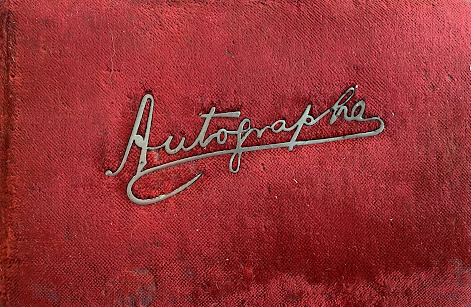FILLED WITH SENTIMENTS,
ACCUSTOMED, CEREMONIOUS
Sarah Elisabeth Hartman Lindsey (1856 - 1937),
filled in as she traveled west in 1886 - 1894,
from Indiana to Illinois to Nebraska
The book is embellished with drawings and quotations from
Evangeline: A Tale of Acadie
by Henry Wadsworth Longfellow (1807-1882)
 |
| Oft on autumnal eves, when without
in the gathering darkness Bursting with light seemed the smithy, through every cranny and crevice . . . |
 |
| Bright rose the sun next day;
and all the flowers of the garden Bathed his shining feet with their tears, and anointed his tresses With the delicious balm that they bore in their vases of crystal. |
 |
| Filled was the air with a dreamy and magical light;
and the landscape Lay as if new-created in all the freshness of childhood. Peace seemed to reign upon earth . . . |
Here are a couple of my favorites:
 |
| I don't know who Lillie Ely was to Sarah, but I love what she wrote: "In memory's basket drop one pearl for me." |
 |
| On the other hand, this signature I know well!
It is that of my great-grandfather, Sarah's husband, James Sankey Lindsey. In the happier times, it was his way to call her "Sallie" and hers to call him "Jimmie." "Sallie It seems so strange and it makes me laugh to think that you want MY authograph Jas. S Lindsey Sheldon, Ill July 2, 1886 |
Reading these, and so many other, quaint inscriptions, I could hear a soundtrack of golden oldies from my own coming of age: autographs, photographs, memories, traces. Though Sarah herself would have never heard these nostalgic tunes, she surely had other evocative melodies floating through her memory as she perused the treasured messages in this keepsake album that she saved all of her life and passed down to my mother.
Photographs and Memories
[1974]
Photographs and memories
Christmas cards you sent to me
All that I have are these
To remember you
Memories that come at night
Take me to another time
Back to a happier day
When I called you mine
But we sure had a good time
When we started way back when
Morning walks and bedroom talks
Oh how I loved you then
Summer skies and lullabies
Nights we couldn't say good-bye
And of all of the things that we knew
Not a dream survived
Photographs and memories
All the love you gave to me
Somehow it just can't be true
That's all I've left of you
But we sure had a good time
When we started way back when
Morning walks and bedroom talks
Oh how I loved you then
Music & lyrics by Jim Croce (1943 – 1973)
Traces
[1969]
Faded photographs, covered now with lines and creases
Tickets torn in half, memories in bits and pieces
Traces of love, long ago that didn't work out right
Traces of love
Ribbons from her hair, souvenirs of days together
(Things we used to share, souvenirs of days together)
The ring she used to wear, pages from an old love letter
Traces of love, long ago that didn't work out right
Traces of love, with me tonight
I close my eyes and say a prayer
That in her heart, she'll find a trace of love still there
Somewhere
Traces of hope in the night that she'll come back and dry
These traces of tears from my eyes
Music & lyrics by Buddy Buie, J. R. Cobb, Emory Gordy Jr. Performed by Classics IV
Thanks to my cousin Cindy,
who helps me keep track of
everything we know about Sarah today,
including her papers, photographs, and artifacts.
Here we are: Cindy & Kitti, second cousins, once removed.
Sarah's great - great- granddaughter & great - granddaughter: Portrait of Sarah, along with snapshot of Kitti & Cindy
“And it is surely astounding to reflect that not once in the three billion years since life began has your personal line of descent been broken. For you to be here now, every one of your ancestors had to successfully pass on its genetic material to a new generation before being snuffed out or otherwise sidetracked from the procreative process. That's quite a chain of success.”Next Fortnightly Postfrom The Body: A Guide for Occupants (p 7)
*****************
“Consider the fact that for 3.8 billion years, a period of time older than the Earth's mountains and rivers and oceans, every one of your forebears on both sides has been attractive enough to find a mate, healthy enough to reproduce, and sufficiently blessed by fate and circumstances to live long enough to do so. Not one of your pertinent ancestors was squashed, devoured, drowned, starved, stranded, stuck fast, untimely wounded, or otherwise deflected from its life's quest of delivering a tiny charge of genetic material to the right partner at the right moment in order to perpetuate the only possible sequence of hereditary combinations that could result -- eventually, astoundingly, and all too briefly -- in you.”from A Short History of Nearly Everything
both by Bill Bryson
Thursday, July 14th
Between now and then, read
THE QUOTIDIAN KIT
my shorter, almost daily blog posts
www.dailykitticarriker.blogspot.com
Looking for a good book? Try
KITTI'S LIST
my running list of recent reading
www.kittislist.blogsppot.com

































